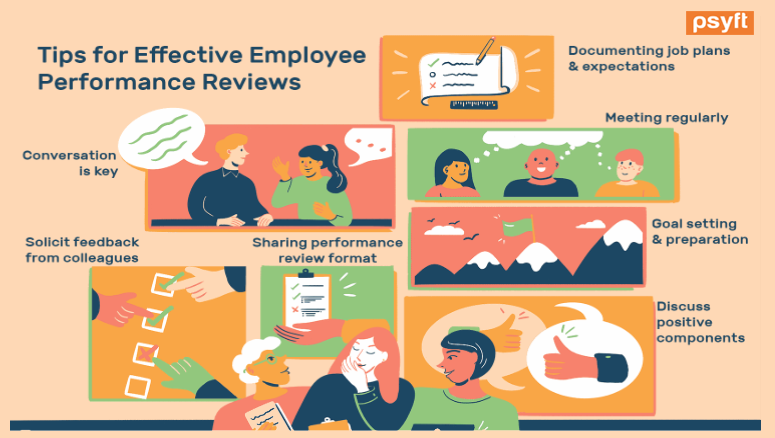Blogs
Get latest insights on what's trending in the HR world - Talent Search, Talent Assessments, Psychometrics, Employee Engagement, Appraisals & much more.

Tips for Tackling Year-End Performance Reviews
03rd November 2022
Traditional employee appraisal approaches are a lot more complicated and convoluted for both managers and employees. Neither gets a clear picture if it’s a broad overview of performance and not detail-oriented.
Every organization has a once-a-year overall performance evaluation. But now most companies have realized it ought to be a part of a larger performance evaluation strategy.
Be it an annual evaluation, a quarterly review, or a monthly performance check-in, these performance reviews can be tricky. Managers need to find the art of balance while sharing honest feedback on an employee’s performance. Appreciate their efforts and good work and also point out the areas for improvement.
What Is a Performance Review?
An overall performance assessment is a two-way, individualized verbal exchange between a supervisor and a worker on overall performance, development, and growth. Conversations revolve around what went well and what did not. How did the employee perform when compared to the goals that they had to accomplish? Traditionally, performance evaluations happened only at the end of each financial year. But these days, companies have embraced a holistic approach to performance reviews and thus have quarterly or, in some cases, monthly reviews.
What Are the Elements of an Effective Performance Review?
Frequent performance reviews: These are quarterly or monthly discussions on overall performance, together with a year-end summary of common themes, notable accomplishments, and next steps. This makes it possible for managers and staff to agree on goals, progress, and overall performance.
Employees understand where they stand and what they can do to improve. Managers provide on-the-job training and support in overcoming challenges. Organizations benefit from a steady flow of information on individual and group performance.
A quarterly or monthly overall performance review cycle is often abandoned by firms because it feels like a significant time commitment. But if you're just having casual discussions, they don't need to be extensive, substantial, or exhaustive to be beneficial.
Two-way conversations: Both managers and employees should contribute to communication, and employees should be just as interested in education as managers are.
Even though there isn't always a one-size-fits-all solution for all discussions about overall performance, every communication should build trust, reduce anxiety, foster clarity, and demonstrate alignment.
Transparent reviews: One of the best ways to reduce tension is to bring staff into the process early and keep them involved in education and planning. Performance opinions may be stress-inducing. The most critical issues must be covered in a clear, covered in a clear, collaborative schedule developed by managers with each employee There should be no surprises; both sides must know precisely what to expect.
Focus on growth: Overall performance assessments have historically focused on the past—how the year went, what went well, and what didn't go well. Employees cannot change the past, so it is very demotivating to judge them based on circumstances they have no control over.
The majority of your performance dialogues must focus on the fact that personnel do have the power to change what happens in the future. While it is appropriate to reflect on the past, managers, and staff must also set out time to look forward.
Why Are Performance Reviews So Important?
Over the past few years, the entire performance assessment has evolved. The idea that performance reviews are ineffective has received a lot of attention. But the truth is that employee engagement and retention depend heavily on overall performance discussions.
Why are discussions about overall performance important? Considering the significant impact they have on the success of your employees, teams, and employer as a whole.
Employee success: The perfect opportunity to build or destroy trust is during performance conversations; conversations need to be open and honest and promote thoughtfulness among employees, managers, and the entire organization. Employees should and must be aware of where they stand in terms of overall performance. An employee’s success can be measured by tracking these metrics:
- Assisting the team in identifying their needs, goals, and difficulties
- Letting management know about obstacles and decisions before they have an impact on performance as a whole
- Creating opportunities for discussion regarding feedback and stronger alignment.
Team success: Performance discussions give managers a clear picture of how each team member is performing, which helps them compare the overall performance of the team. They will comprehend the team's strengths, weaknesses, areas for improvement, how to change goals, and the team's ability to accomplish challenging goals.
Organizational Success: Companies may struggle to achieve important goals and visions if employees are not united and on a clear path to their personal success. Managers can connect employees to the organization's wider goals and challenges through performance dialogues.
Additionally, they give businesses the data they require to make crucial decisions about people related to pay, promotions, development, position changes, exits, and more.
How Can Managers Prepare a Performance Review?
Any communication about employee performance should be handled by managers with care and supported by numerous facts and illustrations. In this, we will discuss how to create a comprehensive performance evaluation by:
- Syncing overall performance evaluation criteria, goals, and progress
- Gathering records and examples
- Preparing notes and agenda
- Finding the proper time for the performance evaluation meeting
- Setting expectations for employees
Syncing overall performance evaluation criteria, goals, and progress-
Managers and employees need to be aware of what constitutes acceptable and unacceptable performance, and this starts with firms' having clear performance criteria and goals. Effective performance standards should support managers and staff by:
- Assessing impact
- Explaining success
- Showing performance strategies that are effective
Managers can also provide support by focusing on what employees are doing well and finding ways to steer them in the right direction rather than allowing them to remain negative. Each performance communication offers the chance to build trust by letting the person being supported know where they are, allowing them to contribute, and providing direction for where they want to go.
Finding the proper time for the performance evaluation meeting: It could take some persuasion to increase the frequency of performance talks for your company, but the more frequently you meet, the more impact your performance reviews will make.
Finding time is challenging. And it might be more difficult to get into the right mental and emotional state. However, by doing performance reviews in a considerate manner, the employees will feel heard, supervisors will receive more effective training, and the business will see results.
The setting you choose for your chats about overall performance has a significant impact on the conversation's mood. Consider the message you might be sending based entirely on the time, place, degree of noise, and comfort of your meeting room, keeping in mind your workstation.
Gathering records and examples: Performance discussions are entirely dependent on the opinions of the manager. Managers must approach discussions of employee performance with detailed personnel data from a variety of sources. These details should improve communication and foster a good relationship between the employer and the employee.
- Engagement survey responses
- Notes from 1-on-1 meetings
- Examples of recognition
- Recent remarks from pulse surveys
- Talent assessment ratings
- Previous overall performance conversations
- Hiring documents
- Strengths and paintings fashion tests
- Input and 360-diploma remarks from different managers or colleagues
These are some of the arenas from where managers can gather their data.
Preparing notes and agenda: Each event must collaborate to create a shared schedule and notes with key talking points in order to give managers and staff the best opportunity to have meaningful conversations about performance.
This will help to ease some of the communication tension and might provide employees an opportunity to contribute to their preparations for the assembly.
Additionally, it enables staff to modify the schedule to suit their needs. Managers can practice active listening rather than lecturing when employees are encouraged to bring up topics they need to discuss.
Your meeting schedule should also include the time and location of your meeting, as well as any supplementary information that can help with communication.
Setting expectations for employees: Sometimes having a talk about performance is challenging. These meetings might help determine why employees aren't achieving their goals or desires and how to help them do better. Align expectations for the meeting itself to get things going right.
An employee must first comprehend how they fit into the process of getting it ready for assembly. They must review the agenda, add the topics they wish to discuss, and ascertain where and when the meeting will be held.
Second, employees must be aware of the materials to bring to the meeting and the documents that the supervisor will likely refer to or bring up during the conversation.
Finally, they need to have a clear understanding of what their responsibilities will be following the meeting and how their manager intends to support their success.
In Conclusion
Communication about overall performance shouldn't stop after the meeting. Managers and staff must review their notes, establish the next steps, and follow up with comments and feedback when the conversation is over. Performance dialogues feel unresolved without those items. Creating a mobility plan is essential if you want your evaluation to genuinely improve overall performance. Performance discussions must occur frequently.
Put the next performance discussion on the calendar after your meeting is finished. Even better, plan a series of dialogues to take place over the year. Setting a regular cadence demonstrates your commitment to the sustained growth and development of your staff, whether those sessions occur quarterly or monthly.
Even if your company hasn't made the switch to more casual chats, managers may find it helpful to establish an open-door policy with staff so they feel comfortable discussing their performance throughout the entire year. A fantastic way to move toward a continuous performance communication approach is to combine this coverage with one-on-one meetings and pulse evaluations throughout an employee's tenure.
Recent Articles
- When Everyone Wants WFH - Tips To Manage An Expanding Team Of Remote Employees
- 5 Proven Strategies To Retain Your Best Talent In 2022
- Why Organizations Should Take Exit Surveys Seriously
- How To Create A Culture Of Recognition In The Workplace
- Why Manager Effectiveness Survey Is Important For A Workplace
News Center
- India Today - 7 reasons companies ask for psychometric tests
- Business World - AI - The New Secret Sauce in Psychometric Assessments
- DNA - HR Trends for 2018
- The Hindu - Psychometric Assessment a "game changer" in hiring
- Entrepreneur - 9 ways to promote actionable feedback at organisations
- Human Capital - Looking Beyond Performance Appraisals





